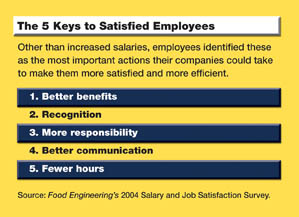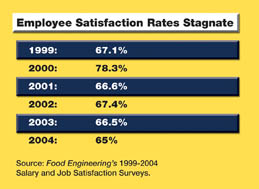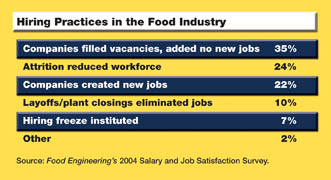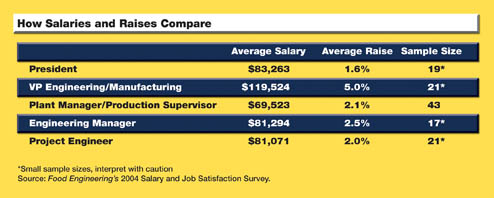Steady as she goes. If there was one overarching message inFood Engineering's2004 Salary and Job Satisfaction Survey, that was it. Food industry professionals are remaining at their jobs longer, despite increasing workloads, modest raises and increased medical insurance payments. Does that mean they are content? Not necessarily. "Up to 70 percent of all professionals are either actively or passively looking at any given point in time," says Wade Palmer, a headhunter in the food and beverage industry for 30 years and president of www.careersinfood.com.

In fact, when it comes to money, nearly two-thirds of FE respondents received salary increases. Nearly half of the survey respondents reported salary increases of 3 percent or less and another 28 percent of respondents said their salaries increased by 4-5 percent. These figures are pretty much inline with the nation as a whole. According to a WorldatWork survey of human resource directors, the average salary increase in the US this year was 3.5 percent.

Despite the additional time served with their current employers, respondents are no more satisfied with their jobs today than they were last year at this time. In fact, satisfaction seems to be at somewhat of a standstill with 65 percent of respondents reporting that they are more than somewhat or very satisfied with their jobs (compared to 66.5 percent in 2003).
Perhaps satisfaction has stagnated because increasing medical insurance and dental insurance payments offset the salary increases that two-thirds of the respondents received. More than 40 percent of respondents reported that their medical insurance payments increased this year and one-third reported increased dental insurance payments.

Can't buy happiness
Although more money may lure the average US employee to leave a company, thoseFEsurvey respondents who are more than somewhat or very satisfied with their jobs, often did not cite money as the reason. As one respondent said, "I have enjoyable work, a great group of people to work with and a variety of projects." Another agreed, "I have the proper personnel working for me."Our satisfied respondents also tended to enjoy the type of work they do, have adequate responsibility for projects and be challenged by them. "I have enough guidance," said one respondent, "but I still have the ability to design and perform projects as I see fit." But, of course, not every food operations or manufacturing employee walks around the plant with a spring in his step. Of those somewhat or completely dissatisfied with their jobs, reasons ranged from a lack of resources and too little help to "pay level versus level of responsibility."
Picking up the slack
Increasing workloads, cited by some as a reason for their dissatisfaction, continue regardless of employees' love level for their work. More than 50 percent of total respondents noted increased production in their plants but with no additional employees to help. One-third of employees were directed to fill the gaps and 23 percent of the respondents surveyed faced an increasing amount of work but were fortunately able to add new staff to help. "Trying to become more efficient so we can do more production with no change, or minimal change, in hiring employees" is one of our top concerns, said one respondent.
Though new jobs aren't being created in record numbers and attrition eliminated a number of jobs, FE respondents rated their job security higher than last year. The average security rating, on a five-point scale, was 3.81, up from 3.75 in 2003 and 3.78 in 2002.

In fact, the need for more help in the face of increasing production resonated throughout this year's survey. "Rising costs of benefits, increased workload and no manpower to cover [results in] poor morale," noted one respondent. "[We need to] properly manage our growth and control our costs to stay profitable," said another respondent. "[We need to] work more efficiently." Pressure to improve efficiencies and reduce costs without adding staff is a top concern in food and beverage manufacturing. Perhaps this year the industry has moved one step closer to at least retaining the employees it needs to accomplish its goals.
Who answered the survey?
The food manufacturing universe is diverse, asFood Engineering's2004 Salary and Job Satisfaction Survey demonstrates. Plant managers, production supervisors and vice presidents of manufacturing accounted for the largest number of survey respondents totaling 34 percent. Project engineers, engineering managers and engineering vice presidents represented 25 percent of those surveyed. Sanitation managers (5 percent), quality control managers (4 percent), and technical directors (4 percent) also responded.More women answered the survey this year than last (19 percent compared to 11 percent in 2003) and eleven percent of the total respondents were company presidents. On average, most of these professionals had 20 years of experience in the food industry.
By far, most respondents work for companies with more than one location (70 percent), although both large and small corporations were represented. One-third of companies have 5,000 or more total employees, while 27 percent had less than 100 total employees at all locations. On the individual level, survey respondents typically worked at locations with less than 100 employees (53 percent).